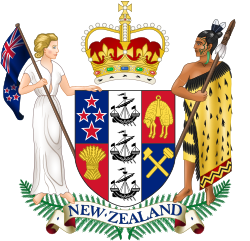| This article is part of a series on the |
| Monarchy of New Zealand |
|---|
 |
| New Zealand portal |
 |
|---|
The Realm of New Zealand is the area over which the monarch of New Zealand is head of state. The realm is not a federation but is a collection of states and territories united under its monarch. New Zealand is an independent and sovereign state that has one territorial claim in Antarctica (the Ross Dependency) and one dependent territory (Tokelau). [1] The Realm of New Zealand encompasses the three autonomous jurisdictions of New Zealand and its associated states of the Cook Islands and Niue. [2]
Contents
- Overview
- Governor-general
- Entities within the Realm
- Cook Islands and Niue
- New Zealand
- Future of the Realm
- See also
- References
- Sources
- External links
The Ross Dependency has no permanent inhabitants, while Tokelau, the Cook Islands and Niue have indigenous populations. The United Nations formally classifies Tokelau as a non-self-governing territory; the Cook Islands and Niue are self-governing. The governor-general of New Zealand represents the monarch throughout the Realm of New Zealand, though the Cook Islands have an additional king's representative.
The four states and territories form an informal currency union but not a customs union; each is in its own customs zone. [3] [4] [5]

